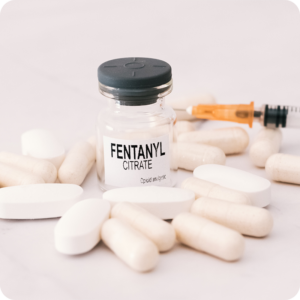Since the early days of illicit drugs, many different substances have been cut into other drugs to stretch the amount of drug available. In most cases, this is done to create a larger profit for dealers, while other dealers are looking to change the drug’s effects. Unfortunately, another result of this practice is increased drug overdoses, especially when the desired drug is cut with a more powerful substance.
Fentanyl has recently been in the news for that exact reason—dealers cut small amounts of this cheaper, more potent opioid into other drugs to make the resulting combination less expensive, more powerful, and more addictive. Now, there’s a new substance finding its way into the drug market that poses a similar risk. Xylazine, like fentanyl, has a legitimate use and has been used in veterinary medicine for a long time. However, it is now posing a danger due to its presence in the illicit drug market. In 2019, Xylazine was detected in over 31% of opioid overdoses in Philadelphia, up from a mere 2% in previous years. It’s clear that Xylazine is the next substance causing serious issues for those suffering from substance use disorder.
What Is the Drug Called Xylazine?

Xylazine is a non-opioid, nervous system depressant first created in 1962. It has been used for years in the veterinary field, providing anesthesia, muscle relaxation, sedation, and pain relief for non-human mammals. The typical duration of any side effects is four hours. The drug can be given either subcutaneously, intramuscularly, or intravenously.
Xylazine is only authorized for veterinary purposes in the United States by the US Food and Drug Administration (FDA). While xylazine isn’t labeled as a controlled substance, it cannot be acquired without having a veterinary license. It is available as a liquid and is typically administered in combination with other substances to activate specific receptors in the body. After human drug trials revealed that xylazine caused bradycardia and hypotension, it wasn’t deemed safe for human use.
Is Xylazine a Tranquilizer?
Xylazine is used as an approved tranquilizer in veterinary medicine only, and it does produce tranquilizing effects since it acts to depress the central nervous system. It produces extremely sedating effects and has recently gained popularity in both the United States and Puerto Rico. In Puerto Rico, where it was first used to adulterate illicit drugs, it is referred to as anestesia de caballo. In the US, xylazine is occasionally referred to as tranq or tranq dope, due to its tranquilizing effects.
However, xylazine is most often seen as an additive, cut with other drugs. Frequently, drugs like heroin, cocaine, and fentanyl are cut with xylazine. This can not only enhance the effects of the drug of choice, but also lead to increased profits for drug distributors. Unfortunately, it can also lead to overdose. We mentioned the recent surge in xylazine-related deaths in Pennsylvania, and there is an increasing presence in other states as well. In 2021, the state of Maryland reported that xylazine was identified in 1 of every 5 deaths due to drug overdose.
What Is Xylazine Used For?

As noted, xylazine is used as a tranquilizer, muscle relaxer, and emetic in veterinary medicine. Veterinarians use the drug during the surgical process and to make animals easier to handle when they require procedures that necessitate handling. It has also been used by veterinarians to induce vomiting in some animals, particularly cats. To provide anesthesia for cattle, Xylazine is typically combined with ketamine. The same combination in smaller doses can be used to produce calming effects in dogs, deer, cats, sheep, and rats.
The muscle relaxing effect xylazine produces inhibits impulses in the central nervous system and can create a state that is akin to sleep. In fact, when animals receive an injection of xylazine, the respiratory rate drops until it is very much like natural sleep. In some animals, xylazine can cause side effects such as hypotension, hypertension, or respiratory depression. Additionally, there is the possibility that tissues may lose some sensitivity to insulin, and hyperglycemia (increased blood sugar) may occur.
Is Tranquilizer an Opioid?
Xylazine, or tranq, produces tranquilizing effects similar to opioids, but is not an opioid. For animals and humans alike, it acts like a sedative and also demonstrates pain relieving effects as well. However, since it is often cut into heroin and other opioids, it is often identified alongside opioids during overdose situations. Because it isn’t an opioid, xylazine won’t respond to naloxone, the treatment for opioid overdose.
Xylazine seems to be following a similar course to fentanyl, in that it is a powerful substance with a legitimate purpose that has been co-opted to increase profits. Much like fentanyl, xylazine is cut into other substances like heroin or cocaine. When people purchase these drugs, thinking they are pursuing a regular heroin high, they may experience an even more powerful high from both heroin and xylazine, putting them at significant risk for overdose and death.
Testing for xylazine is also not a standard procedure in deaths due to overdose, so it’s even more difficult to predict just how prevalent this substance is compared to opioids like fentanyl. This, unfortunately, leaves people with substance use disorder (SUD), opioid use disorder (OUD), or even those new to recreational drug use in a very dangerous landscape. When there is no way to know exactly which drugs a drug of choice may be cut with, drug use becomes far riskier.
How Does Xylazine Affect Humans?
Xylazine is an agonist affecting alpha-2 adrenergic receptors and reduces how much dopamine and norepinephrine are released, which leads to muscle relaxation, pain relief, and sedation. As a result, the effects of xylazine in humans are much like the effects the drug causes in animals. However, the effects for humans can be significantly more severe. In humans, xylazine can cause bradycardia (slowed heart rate), extreme respiratory depression, and hypotension (reduced blood pressure). Because this is a drug developed for animals, researchers have not discovered the full extent of the effects xylazine will have on the human body, especially if used long-term. In this way, it is extremely dangerous.
Other negative side effects may include:
- Disorientation
- Drowsiness
- Blurred vision
- Staggering
- High blood sugar
Researchers studying xylazine in Puerto Rico discovered that over 35% of those using xylazine were suffering from skin lesions or ulcers. If you encounter someone who is suffering from the effects of xylazine, they’re likely to be displaying the above symptoms as well as extreme sleepiness or sedation. Because xylazine produces a major tranquilizing effect, humans can feel symptoms that are like a comatose state.
Why Is Xylazine So Dangerous?
 Due to the sedative effects xylazine can have on the human body, it does have some desirability as a street drug. It can be used in a variety of ways, including inhalation or oral use. However, when tranq is used on its own, it is almost always used intravenously. It’s important to restate the fact that xylazine alone isn’t the primary source of concern. Instead, its inclusion with other substances, most notably fentanyl, presents a rising issue. In nearly all cases where xylazine was present in a death related to overdose, fentanyl was also present.
Due to the sedative effects xylazine can have on the human body, it does have some desirability as a street drug. It can be used in a variety of ways, including inhalation or oral use. However, when tranq is used on its own, it is almost always used intravenously. It’s important to restate the fact that xylazine alone isn’t the primary source of concern. Instead, its inclusion with other substances, most notably fentanyl, presents a rising issue. In nearly all cases where xylazine was present in a death related to overdose, fentanyl was also present.
Since xylazine is often combined with other drugs, its sedative effects are of particular concern when combined with opioids that are functionally similar. It seems that xylazine can inflate the most dangerous effects of opioids like fentanyl, including respiratory depression. It may also cause issues during opioid overdose situations where naloxone is used, as naloxone isn’t effective in treating xylazine.
As mentioned, one of the biggest concerns with xylazine is that most people who encounter the drug are unaware that they’re using it, and this can lead to accidental overdose and death. In the Puerto Rico study, more than 20% of respondents reported overdose experiences.
What Does the Emergence of Xylazine Mean?
Fentanyl has become a major public health crisis, affecting individuals seeking to use fentanyl alone, individuals experiencing fentanyl overdose when cut with other drugs, and individuals experiencing overdoses due to inadvertent fentanyl exposure. In the same way that fentanyl seemed to overtake the market, the prevalence of xylazine is growing year over year. It’s difficult to fully predict how xylazine will affect people experiencing substance use disorder, but if the rise in fentanyl deaths is any indicator, we could soon be seeing a xylazine epidemic in the US.
Additionally, advances in technology allow for the creating and testing of new synthetic compounds, making the drug market even more unpredictable. While some of the substances being added to drugs like heroin can be as benign as sugar, adulterants like xylazine are as dangerous as fentanyl.
Seek Help Today

Xylazine is no joke, whether used intentionally as a tranquilizer or experienced inadvertently during opioid use. Either situation can lead to overdose, especially in cases where you aren’t aware you’re consuming xylazine, and what’s worse is that the presence of xylazine can make an overdose more difficult to treat. Unfortunately, as the opioid epidemic continues, overdoses associated with fentanyl and xylazine are likely to become an increasing danger.
Whether you or a loved one have encountered xylazine or another prescription or illicit drug, it is important to seek help as soon as possible. When you contact Stairway Resource Center, our caring staff can help you with your struggle and get you the treatment you so need to begin recovery. Services like transcranial magnetic stimulation, EMDR, CRM, individual and group therapy, and more are available in an intensive outpatient setting, allowing you to get the help you need without uprooting your life.
Misusing prescription medications or illicit drugs puts you at increased risk of overdose from xylazine, fentanyl, and many other adulterants. Rather than suffering in silence, seek help from the team at Stairway Resource Center today.

